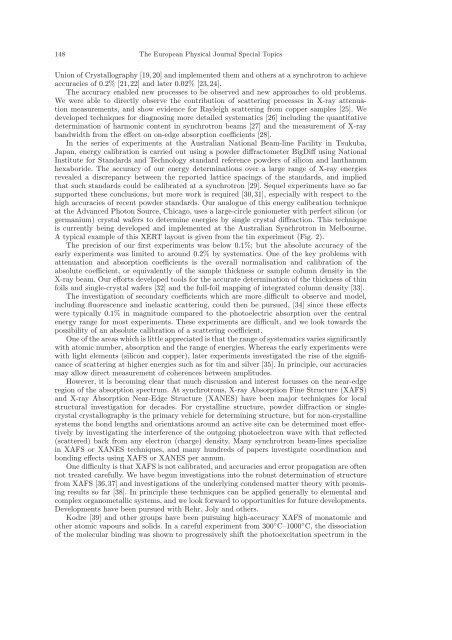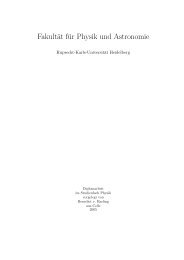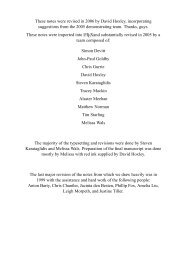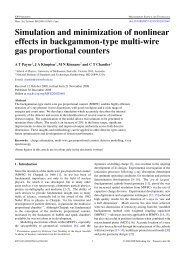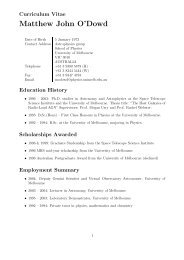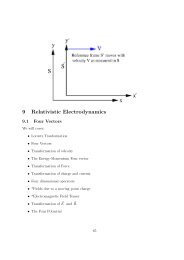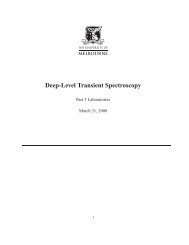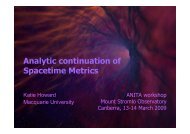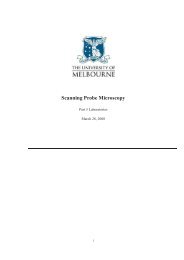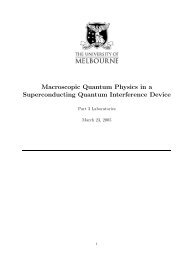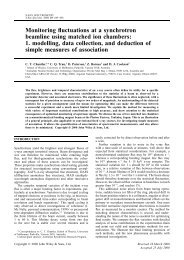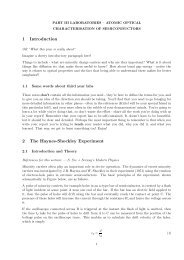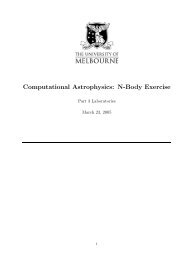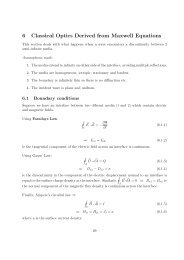C. T. Chantler, Development and Applications of Accurate ...
C. T. Chantler, Development and Applications of Accurate ...
C. T. Chantler, Development and Applications of Accurate ...
Create successful ePaper yourself
Turn your PDF publications into a flip-book with our unique Google optimized e-Paper software.
148 The European Physical Journal Special Topics<br />
Union <strong>of</strong> Crystallography [19,20] <strong>and</strong> implemented them <strong>and</strong> others at a synchrotron to achieve<br />
accuracies <strong>of</strong> 0.2% [21,22] <strong>and</strong> later 0.02% [23,24].<br />
The accuracy enabled new processes to be observed <strong>and</strong> new approaches to old problems.<br />
We were able to directly observe the contribution <strong>of</strong> scattering processes in X-ray attenuation<br />
measurements, <strong>and</strong> show evidence for Rayleigh scattering from copper samples [25]. We<br />
developed techniques for diagnosing more detailed systematics [26] including the quantitative<br />
determination <strong>of</strong> harmonic content in synchrotron beams [27] <strong>and</strong> the measurement <strong>of</strong> X-ray<br />
b<strong>and</strong>width from the effect on on-edge absorption coefficients [28].<br />
In the series <strong>of</strong> experiments at the Australian National Beam-line Facility in Tsukuba,<br />
Japan, energy calibration is carried out using a powder diffractometer BigDiff using National<br />
Institute for St<strong>and</strong>ards <strong>and</strong> Technology st<strong>and</strong>ard reference powders <strong>of</strong> silicon <strong>and</strong> lanthanum<br />
hexaboride. The accuracy <strong>of</strong> our energy determinations over a large range <strong>of</strong> X-ray energies<br />
revealed a discrepancy between the reported lattice spacings <strong>of</strong> the st<strong>and</strong>ards, <strong>and</strong> implied<br />
that such st<strong>and</strong>ards could be calibrated at a synchrotron [29]. Sequel experiments have so far<br />
supported these conclusions, but more work is required [30,31], especially with respect to the<br />
high accuracies <strong>of</strong> recent powder st<strong>and</strong>ards. Our analogue <strong>of</strong> this energy calibration technique<br />
at the Advanced Photon Source, Chicago, uses a large-circle goniometer with perfect silicon (or<br />
germanium) crystal wafers to determine energies by single crystal diffraction. This technique<br />
is currently being developed <strong>and</strong> implemented at the Australian Synchrotron in Melbourne.<br />
A typical example <strong>of</strong> this XERT layout is given from the tin experiment (Fig. 2).<br />
The precision <strong>of</strong> our first experiments was below 0.1%; but the absolute accuracy <strong>of</strong> the<br />
early experiments was limited to around 0.2% by systematics. One <strong>of</strong> the key problems with<br />
attenuation <strong>and</strong> absorption coefficients is the overall normalisation <strong>and</strong> calibration <strong>of</strong> the<br />
absolute coefficient, or equivalently <strong>of</strong> the sample thickness or sample column density in the<br />
X-ray beam. Our efforts developed tools for the accurate determination <strong>of</strong> the thickness <strong>of</strong> thin<br />
foils <strong>and</strong> single-crystal wafers [32] <strong>and</strong> the full-foil mapping <strong>of</strong> integrated column density [33].<br />
The investigation <strong>of</strong> secondary coefficients which are more difficult to observe <strong>and</strong> model,<br />
including fluorescence <strong>and</strong> inelastic scattering, could then be pursued, [34] since these effects<br />
were typically 0.1% in magnitude compared to the photoelectric absorption over the central<br />
energy range for most experiments. These experiments are difficult, <strong>and</strong> we look towards the<br />
possibility <strong>of</strong> an absolute calibration <strong>of</strong> a scattering coefficient.<br />
One <strong>of</strong> the areas which is little appreciated is that the range <strong>of</strong> systematics varies significantly<br />
with atomic number, absorption <strong>and</strong> the range <strong>of</strong> energies. Whereas the early experiments were<br />
with light elements (silicon <strong>and</strong> copper), later experiments investigated the rise <strong>of</strong> the significance<br />
<strong>of</strong> scattering at higher energies such as for tin <strong>and</strong> silver [35]. In principle, our accuracies<br />
may allow direct measurement <strong>of</strong> coherences between amplitudes.<br />
However, it is becoming clear that much discussion <strong>and</strong> interest focusses on the near-edge<br />
region <strong>of</strong> the absorption spectrum. At synchrotrons, X-ray Absorption Fine Structure (XAFS)<br />
<strong>and</strong> X-ray Absorption Near-Edge Structure (XANES) have been major techniques for local<br />
structural investigation for decades. For crystalline structure, powder diffraction or singlecrystal<br />
crystallography is the primary vehicle for determining structure, but for non-crystalline<br />
systems the bond lengths <strong>and</strong> orientations around an active site can be determined most effectively<br />
by investigating the interference <strong>of</strong> the outgoing photoelectron wave with that reflected<br />
(scattered) back from any electron (charge) density. Many synchrotron beam-lines specialize<br />
in XAFS or XANES techniques, <strong>and</strong> many hundreds <strong>of</strong> papers investigate coordination <strong>and</strong><br />
bonding effects using XAFS or XANES per annum.<br />
One difficulty is that XAFS is not calibrated, <strong>and</strong> accuracies <strong>and</strong> error propagation are <strong>of</strong>ten<br />
not treated carefully. We have begun investigations into the robust determination <strong>of</strong> structure<br />
from XAFS [36,37] <strong>and</strong> investigations <strong>of</strong> the underlying condensed matter theory with promising<br />
results so far [38]. In principle these techniques can be applied generally to elemental <strong>and</strong><br />
complex organometallic systems, <strong>and</strong> we look forward to opportunities for future developments.<br />
<strong>Development</strong>s have been pursued with Rehr, Joly <strong>and</strong> others.<br />
Kodre [39] <strong>and</strong> other groups have been pursuing high-accuracy XAFS <strong>of</strong> monatomic <strong>and</strong><br />
other atomic vapours <strong>and</strong> solids. In a careful experiment from 300 ◦ C–1000 ◦ C, the dissociation<br />
<strong>of</strong> the molecular binding was shown to progressively shift the photoexcitation spectrum in the


